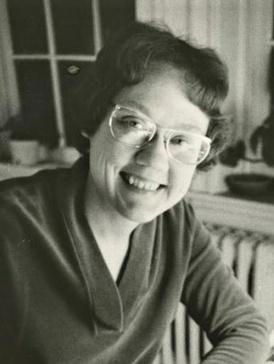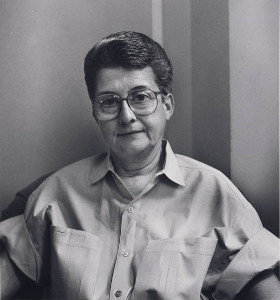Related Research Articles

Dorothy Louise Taliaferro "Del" Martin and Phyllis Ann Lyon were an American lesbian couple based in San Francisco who were known as feminist and gay-rights activists.

The Daughters of Bilitis, also called the DOB or the Daughters, was the first lesbian civil and political rights organization in the United States. The organization, formed in San Francisco in 1955, was initially conceived as a secret social club, an alternative to lesbian bars, which were subject to raids and police harassment.

Booklist is a publication of the American Library Association that provides critical reviews of books and audiovisual materials for all ages. Booklist's primary audience consists of libraries, educators, and booksellers. The magazine is available to subscribers in print and online. It is published 22 times per year, and reviews over 7,500 titles annually. The Booklist brand also offers a blog, various newsletters, and monthly webinars. The Booklist offices are located in the American Library Association headquarters in Chicago’s Gold Coast neighborhood.

The Ladder was the first nationally distributed lesbian publication in the United States. Published from 1956 to 1972, The Ladder was the primary monthly publication and method of communication for the Daughters of Bilitis (DOB), the first lesbian organization in the US. It was supported by ONE, Inc. and the Mattachine Society, with whom the DOB retained friendly relations. The name of the magazine was derived from the artwork on its first cover, simple line drawings showing figures moving towards a ladder that disappeared into the clouds.

Barbara Gittings was a prominent American activist for LGBT equality. She organized the New York chapter of the Daughters of Bilitis (DOB) from 1958 to 1963, edited the national DOB magazine The Ladder from 1963 to 1966, and worked closely with Frank Kameny in the 1960s on the first picket lines that brought attention to the ban on employment of gay people by the largest employer in the US at that time: the United States government. Her early experiences with trying to learn more about lesbianism fueled her lifetime work with libraries. In the 1970s, Gittings was most involved in the American Library Association, especially its gay caucus, the first such in a professional organization, in order to promote positive literature about homosexuality in libraries. She was a part of the movement to get the American Psychiatric Association to drop homosexuality as a mental illness in 1972. Her self-described life mission was to tear away the "shroud of invisibility" related to homosexuality, which had theretofore been associated with crime and mental illness.

Edythe D. Eyde better known by her pen name Lisa Ben, was an American editor, author, active fantasy-fiction fan and fanzine contributor, and songwriter. She created the first known lesbian publication in North America, Vice Versa. Ben produced the magazine for a year and distributed it locally in Los Angeles, California, in the late 1940s. She was also active in lesbian bars as a musician in the years following her involvement with Vice Versa. Eyde has been recognized as a pioneer in the LGBT movement.
Gay Community News was an American weekly newspaper published in Boston, Massachusetts from 1973 to 1999. Designed as a resource for the LGBT community, the newspaper reported a wide variety of gay and lesbian-related news.

Arena Three was a British monthly publication founded by Esme Langley and Diana Chapman in 1964. It was written by and for lesbians and published by the Minorities Research Group (MRG) from 1964 to 1971.

Sinister Wisdom is an American lesbian literary, theory, and art journal published quarterly in Berkeley, California. Started in 1976 by Catherine Nicholson and Harriet Ellenberger (Desmoines) in Charlotte, North Carolina, it is the longest established lesbian journal, with 128 issues as of 2023. Each journal covers topics pertaining to the lesbian experience including creative writing, poetry, literary criticism and feminist theory. Sinister Wisdom accepts submissions from novice to accredited writers and has featured the works of writers and artists such as Audre Lorde and Adrienne Rich. The journal has pioneered female publishing, working with female operated publishing companies such as Whole Women Press and Iowa City Women's Press. Sapphic Classics, a partnership between Sinister Wisdom and A Midsummer Night's Press, reprints classic lesbian works for contemporary audiences.

Barbara Grier was an American writer and publisher. She is credited for having built the lesbian book industry. After editing The Ladder magazine, published by the lesbian civil rights group Daughters of Bilitis, she co-founded a lesbian book-publishing company Naiad Press, which achieved publicity and became the world's largest publisher of lesbian books. She built a major collection of lesbian literature, catalogued with detailed indexing of topics.

Siegessäule is Berlin's most widely distributed queer magazine and has been published monthly, except for two brief hiatuses, since April 1984. Originally only available in West Berlin, it ran with the subtitle "Berlin's monthly page for Gays". In 1996, it was broadened to include lesbian content, and in 2005 it was expanded to reach a wider queer target base, becoming the only magazine of its scale in Europe to represent the full spectrum of the LGBT community. The magazine is available for free at around 700 locations in Berlin, printing 53.688 copies per month. Since March-issue 2013, it has been overseen by chief editor Jan Noll.

Vice Versa (1947–1948), subtitled "America's Gayest Magazine", is the earliest known U.S. periodical published especially for lesbians. Its mission was to express lesbian emotion within the bounds of good taste.

The Gay & Lesbian Review Worldwide is a bimonthly, nationally distributed magazine of history, culture, and politics for LGBT people and their allies who are interested in the gamut of social, scientific, and cultural issues raised by same-sex sexuality. Library Journal described it as "the journal of record for LGBT issues."

Die Freundin was a popular Weimar-era German lesbian magazine published from 1924 to 1933. Founded in 1924, it was the world's first lesbian magazine, closely followed by Frauenliebe and Die BIF. The magazine was published from Berlin, the capital of Germany, by the Bund für Menschenrecht, run by gay activist and publisher Friedrich Radszuweit. The Bund was an organization for homosexuals which had a membership of 48,000 in the 1920s.

Ernestine Eckstein was an African-American woman who helped steer the United States Lesbian and Gay rights movement during the 1960s. She was a leader in the New York chapter of Daughters of Bilitis (DOB). Her influence helped the DOB move away from negotiating with medical professionals and towards tactics of public demonstrations. Her understanding of, and work in, the Civil Rights Movement lent valuable experience on public protest to the lesbian and gay movement. Eckstein worked among activists such as Phyllis Lyon and Del Martin, Barbara Gittings, Franklin Kameny, and Randy Wicker. In the 1970s she became involved in the black feminist movement, in particular the organization Black Women Organized for Action (BWOA).

The Lesbian Tide (1971–1980) was a lesbian periodical published in the United States by the Los Angeles chapter of the Daughters of Bilitis. It was the first lesbian periodical in the US to reach a national audience and the first US magazine to use the word "lesbian" in the title.
Der Kreis was a Swiss gay magazine. Founded as the lesbian magazine Freundschaftsbanner in 1932 it turned into a male-only magazine in 1942 under the name Der Kreis. It was trilingual and distributed internationally and gained significant influence in the homosexual movement at the time until it ceased publication in 1967.
Garçonne was a Weimar-era German magazine for lesbians. It was published from 1926 to 1930 under the title Frauenliebe and from 1930 to 1932 as Garçonne.
The following is a timeline of lesbian, gay, bisexual, transgender and queer (LGBTQ) journalism history.
Helen Jane "Sandy" Sandoz, also known by her pseudonym Helen Sanders, was an American lesbian rights activist and writer. She was involved in the Daughters of Bilitis and its official publication, The Ladder, from 1956 to 1970.
References
- 1 2 "The Mimeograph and the Early Gay Rights Movement: Early Organizing and Publications". University of British Columbia. September 2006. Retrieved May 5, 2014.
- 1 2 3 4 5 Kathleen L. Endres; Therese L. Lueck (January 1, 1996). Women's Periodicals in the United States: Social and Political Issues. Greenwood Publishing Group. p. 96. ISBN 978-0-313-28632-2 . Retrieved December 15, 2015.
- 1 2 3 4 Whitt, Jan (2001). "A "Labor from the Heart"". Journal of Lesbian Studies. 5 (1–2): 229–251. doi:10.1300/J155v05n01_15. PMID 24807577. S2CID 30795300.